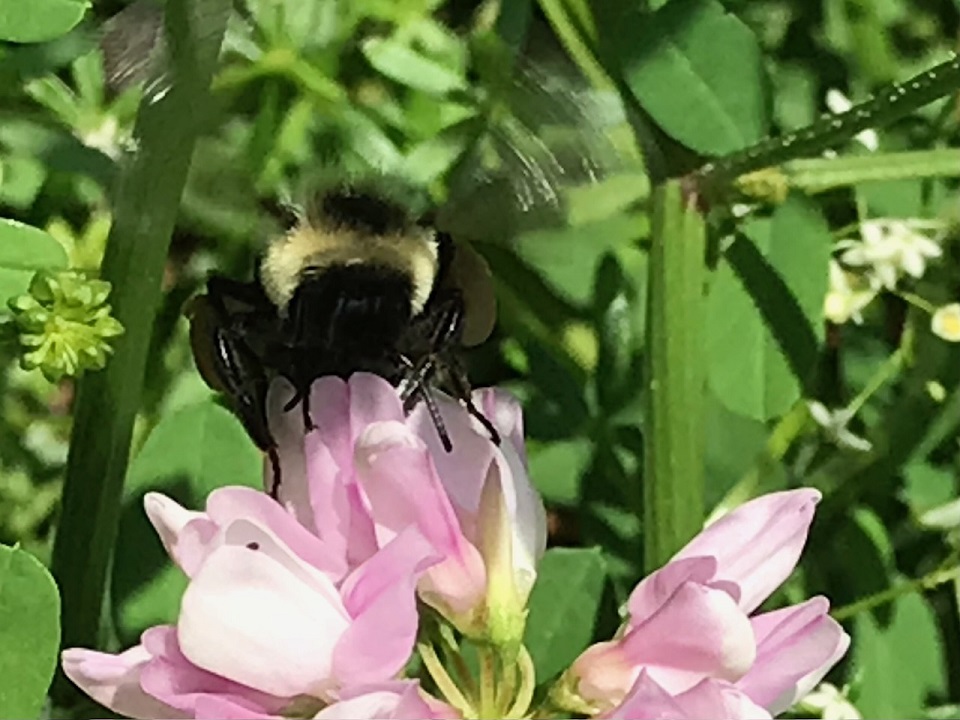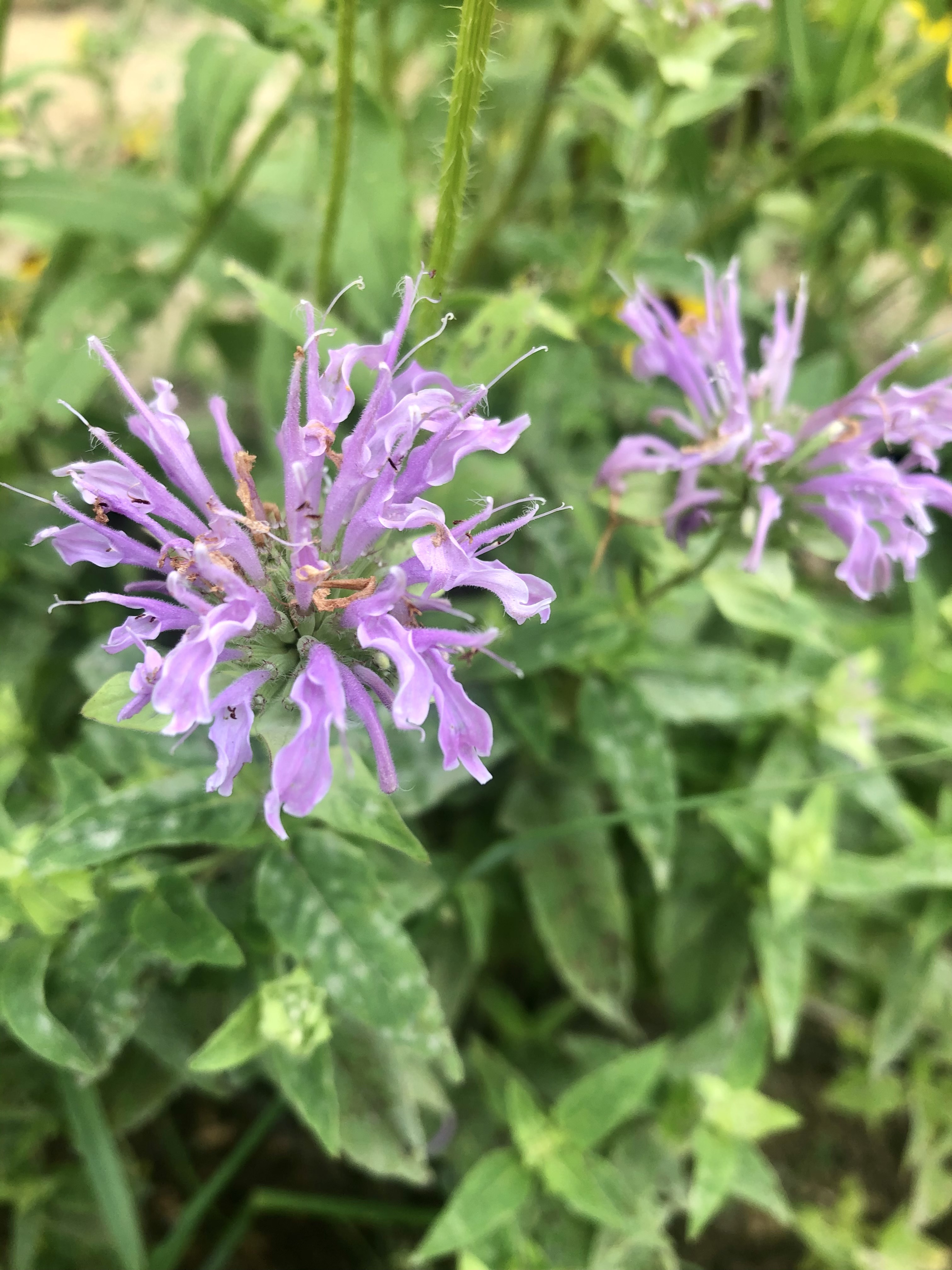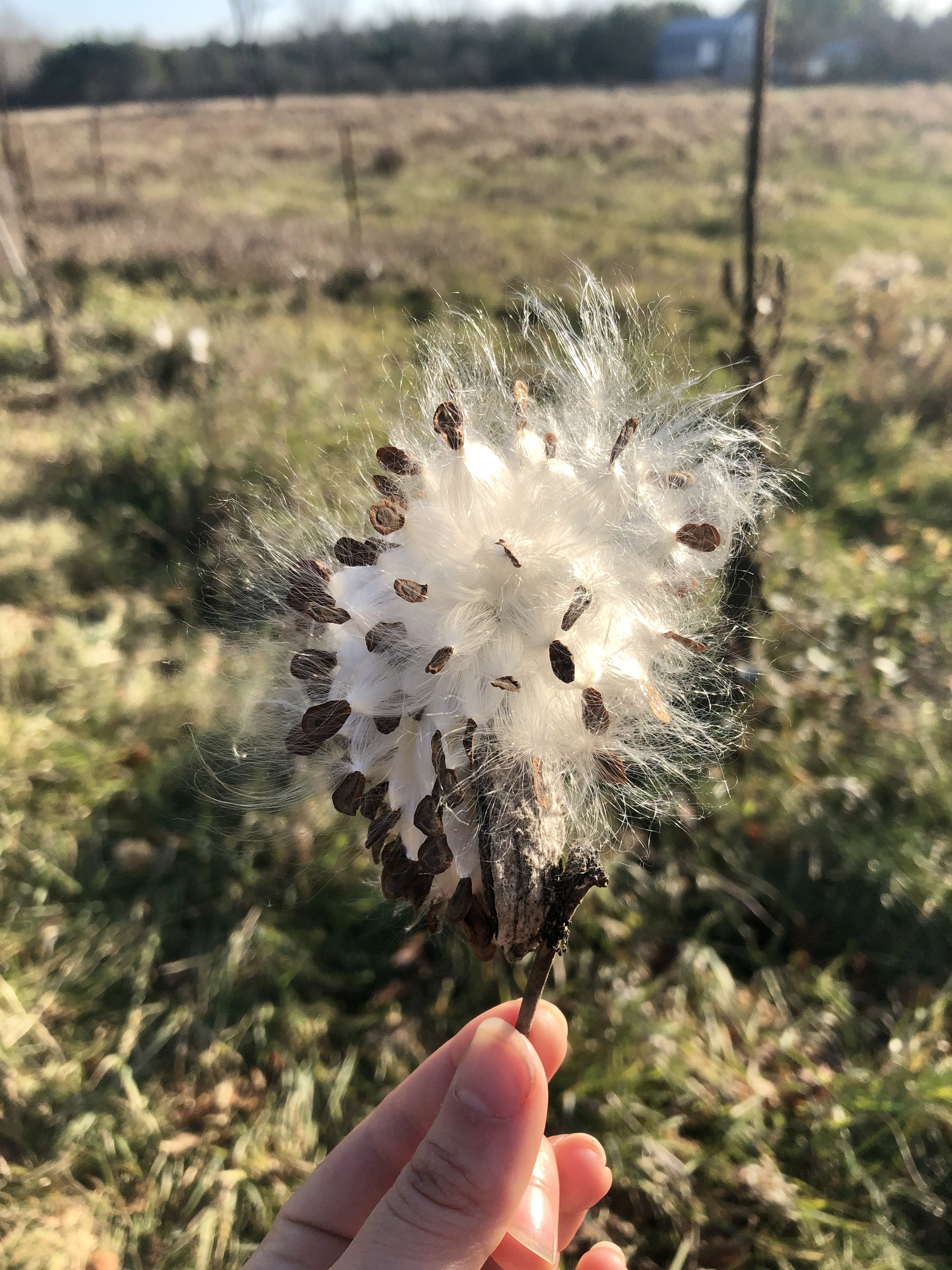Create a Wildlife Habitat

Instead of a manicured lawn, imagine a plot of multicolored wildflowers, magnificently scented, and abuzz with native bees, butterflies, and damsel flies. A mulched pathway winds around herbs and forageable native plants, all ready to harvest and add to tonight's meal. Birds flit and flutter by, catching insects and singing happily. With a little maintenance, your garden can take care of itself and give back in abundance.
Sustainable Merrickville-Wolford (SMW) is building several pollinator gardens in and around Merrickville as a first step toward turning Merrickville-Wolford into a designated Bee City. These gardens will host a variety of native plants grown without the use of herbicides and pesticides. They will provide a safe habitat for bees and butterflies and serve as a waystation for monarchs and other endangered pollinators.
Our first site is now up and running! Established in collaboration with the Lions Club, it is located in the Community Garden area near Merrickville Public School. It will take a couple of years to fully establish, but can be an example for anyone interested in planting their own pollinator garden. Feel free to stop by or contact us at info@sustainableMW.org to find out how you can get involved.
Plant a Pollinator Garden
You don’t have to have a huge yard to create a pollinator garden - even a window box or other small planter can benefit local pollinators as long as you plant native species and avoid using herbicides or pesticides. Native plant species are the best choice since they are ideally suited to the local climate and soil. Not only do they provide food and shelter for wildlife but they also require less water and tending, saving time, resources, and money.
To create a healthy habitat, choose a combination of perennials that bloom at different times of the season. If possible, plant groups of the same species and arrange your garden area in multiple layers of varying plant heights.
Native Species that Attract Pollinators
This list was created for the SMW pollinator gardens in consultation with a local expert. It is a good starting point for anyone interested in setting up their own wildlife garden. Plants labeled with an asterisk are especially important to the survival of Monarch butterflies, (as identified by the World Wildlife Federation).
Herbaceous Perennials
- Allium schoenoprasum (common chive)
Papery purple flowers that are exceptionally attractive to bees. All plant parts are edible. Root systems are mildly allelopathic, so the plant should occupy its own bed section. - Allium sp (flowering onion)
Large globes of purple, white, or pink flowers are showy and attractive to bees and butterflies. - Lupinus perennis (native wild lupine aka sundial lupine)
Native nectar resource for large-bodied bees, especially bumblebees. Needs sandy well-drained soil to prosper. Seeds attract birds and small mammals. - Monarda didyma (Oswego tea)
Bright red, nectar-rich flowers attract long-tongued bees and butterflies, and sometimes Hemaris and other hummingbird moths. - Monarda fistulosa (wild bergamot)
Purple-white nectar-rich flowers attract long-tongued bees and butterflies, and sometimes also Hemaris and other hummingbird moths.
- * Asclepias syriaca (common milkweed)
Fragrant light-pink native milkweed is easy to grow and attracts butterflies (especially monarchs) and bees. Produces large globular clusters of stiff, nectar-filled flowers. No pollen resources except for specialist bees. - * Asclepias tuberosa (butterfly milkweed)
Large umbels of nectar-rich orange flowers attract butterflies and bees. No pollen resources except for specialist bees. - * Asclepias incarnata (swamp milkweed)
Clusters of deep pink flowers attract butterflies and bees. No pollen resources except for specialist bees. Grows well in mucky clay soils. - Delphinium sp (larkspur)
Tall spikes of blue-purple flowers that are attractive to bees and hummingbirds. - Echinops ritro (Veicht's Blue Globe Thistle)
Large blue globe-shaped clusters of nectar-rich flowers attract bees and syrphid flies. Green parts are extremely spiky. - * Rudbeckia hirta (black-eyed susan)
Yellow nectar- and pollen-rich flowers with a brown centre attract a wide array of pollinators including bees, butterflies, moths, beetles, and syrphid flies. - Verbena simplex (narrow-leaved vervain)
Lavender-toned flowers attract small-bodied native bees and butterflies. Requires sandy well-drained soil and not too much competition. - Verbena stricta (hoary vervain)
Large clusters of progressively-blooming purple flowers that are highly attractive to bees.
- * Aster novae-angliae (New England aster)
Large purple flowers presented in diffuse clusters provide late-season food for bees before dormancy. - Helianthus sp (find a local native)
Large yellow flowers provide late-season food for bees before dormancy. Seeds will also feed the birds. - * Solidago spp. (goldenrod)
Fluffy golden flower spikes in various shades of yellow are a valuable food source for a variety of pollinators, particularly the Monarch butterfly.
- Coreopsis lanceolata (lance-leaved coreopsis)
Pretty yellow flowers that attract a broad range of pollinators including bees, butterflies, moths, beetles, syrphids, and flies. - * Echinacea purpurea (purple coneflower)
Large pretty purple flowering heads that attract bees, butterflies, syrphids, and beetles. - Liatris spicata (blazing star)
Tall spikes of purple flowers attract bees and butterflies. - Penstemon digitalis (foxglove beardtongue)
Loosely displayed spikes of large white flowers produce significant early season nectar for butterflies, moths, and bees. - Penstemon hirsutus (hairy beardtongue)
Loosely displayed spikes of large purple flowers produce significant early season nectar for butterflies, moths, and bees.
Shrubs
- Amelanchier spp. (serviceberry, Saskatoon berry)
Pretty white flowers that attract considerable bee attention, and then very nice edible fruit in late summer that attracts the birds. - Forsythia
One of the spring foods for flower-dependent insects, it is heavily perfumed, producing scented oils to attract oil-collecting bees as well as pollen and nectar. - Physocarpus opulifolius (ninebark)
Copious clusters of small white flowers that are particularly attractive to bees. A low-maintenance shrub. - Rosa acicularis (prickly wild rose)
Fragrant pink flowers with bright yellow centres produce copious pollen for a wide variety of bees. Rose hips are also an attractive food source for birds and mammals in the fall. - Vaccinium angustifolium (low bush blueberry)
Glossy leaves grace this subtly-blooming flower which is very attractive to bees, including bumble bees and short-tongued bees. The berries are attractive to birds and small rodents. - Weigela (Bristol ruby)
Large clusters of red-pink produce copious nectar. Especially attractive to hummingbirds.
- Salvia officinalis (sage)
Spikes of nectar-rich purple flowers are highly attractive to bees and butterflies. Slow-growing, fragrant plant with attractive foliage.
Vines
- Clematis virginiana (virgin's bower)
Clusters of white flowers with nectar and pollen available in late season for bees; bears attractive fluffy seed heads into winter.
Create your own Monarch Waystation
Each year the eastern monarch butterfly migrates over 4,000 km from the forests in central Mexico to the US and Canada where they breed. This lengthy migration route leaves monarchs extremely vulnerable to the effects of climate change, urban development, and deforestation.
In our region, the increased use of herbicides and pesticides, as well as mowing, along roadsides and on agricultural land is having a devastating effect on milkweeds and other native plants critical to the survival of the population. Monarchs lay their eggs on milkweed plants, and the larvae feed exclusively on the milkweed leaves; while other late-blooming nectar producers provide energy for the long journey south in the fall.
People all across Canada, the US, and Mexico are working to create waystations along the monarch migration corridor. You can help by adding milkweeds and nectar sources to existing gardens and public spaces or by maintaining natural habitats. You can even have your habitat certified as an official Monarch Waystation by Monarch Watch.
Plant a Tree
It’s said that the best time to plant a tree was 20 years ago, and the second best time is now. Trees are vital to survival - they sequester carbon from the atmosphere, provide oxygen, reduce heat, stabilize the soil, and provide food and shelter, not to mention their beauty and health benefits.
When choosing a tree, be sure to consider the growing conditions (soil, moisture and light), as well as its eventual height, root spread, and whether it is prone to disease. Native trees that provide food and shelter to wildlife are always the best choice. As well, they are adapted to the local soil and climate, ensuring a better success rate.
Tree Species for Wildlife, Pollinators, and Food Security
Selected by a world-recognized leader in the field, these trees provide optimal food and shelter for the wildlife in our area. Many were traditionally important food sources for people and could be again.
- Abies balsamea; Picea glauca (fir and spruce)
10 to 25 m, shallow roots, moist soils
Members of the pine family are good options for small, shady yards or damp/swampy areas where other trees would not thrive. They provide food and crucial year-round shelter for birds and small animals. - Acer saccharum (sugar maple)
20 to 35 m, wide spreading roots, deep rich dry soils
Provides a delicious food source (maple sap/syrup). Seedlings are easily transplanted and will grow more vigorously if given some shade, not ideal for thin/poor soils. - Carya laciniosa; Carya ovata (shellbark and shagbark hickory)
20 to 30 m, rich, moist soils
Good carbon-sequestering trees, hickories are a favourite for foraging animals and were a staple traditional food source. The nuts can be shelled and eaten raw or cooked, whole or ground, and are considered to be similar to pecans in quality of taste. - Catalpa speciosa (catalpa)
10 to 30 m, varied soils
The showy flowers attract beneficial pollinator species and they release a sweet extrafloral nectar which also helps attract insects. The trees cope well with climatic stress and can be aggressively pruned making them well suited for backyards. They also produce large seed pods that provide food for birds such as cardinals. - Celtis occidentalis (hackberry/sugarberry)
10 to 15 m, varied soils
A small, hardy, drought-resistant and easily transplanted species. They produce berries that are an incredibly important fall/winter food source for small animals and especially birds. - Juglans cinerea (butternut)
12 to 25 m, deep soil, full sun/shade intolerant (prefers open fields)
An endangered species, butternuts are highly susceptible to a deadly fungal disease with no known cure. However, some individual trees seem to be tolerant to the disease and there are efforts underway to propagate these. They provide another great animal and human food source with nuts high in omega-3 fatty acids. Fast growing but short-lived, butternuts, like their relative black walnut, produce juglone which is toxic to many other plant species. - Liriodendron tulipifera (tulip tree)
Up to 35 m, full sun, deep rich/drained soils
Like the cucumber tree, this rare species requires the right conditions but provides showy tulip-like flowers and nectar/fragrance which attract beneficial pollinator species. It is fast-growing but requires a fair bit of space. - Magnolia acuminata (cucumber tree)
Up to 25 m, full sun, deep rich/moist soils.
The only magnolia native to Canada, this rare species is hardier and larger than the rest. It would be good to plant more given its scarcity, although it requires the right conditions. The flowers and nectar attract pollinators and the seeds provide food for birds and small animals. The fragrance emitted may have beneficial effects for humans as well. - Quercus alba (white oak)
15 to 35 m, deep spreading roots, prefer rich well-drained soil and full sun
One of the best trees for carbon sequestration, it is also an excellent high-protein human and animal food source and insect habitat. The acorns were traditionally dried, ground and used to make cakes or thicken soups, and also simply roasted or boiled and peeled as a snack. - Quercus rubra (red oak)
18 to 25 m, deep spreading roots, prefer rich well-drained soil & full sun
Also good for carbon sequestration, as well as animal foraging and insect habitat (the higher tannin acorns are very bitter and not recommended for human consumption unless extensively boiled). An attractive shade tree that transplants well and grows quickly.



